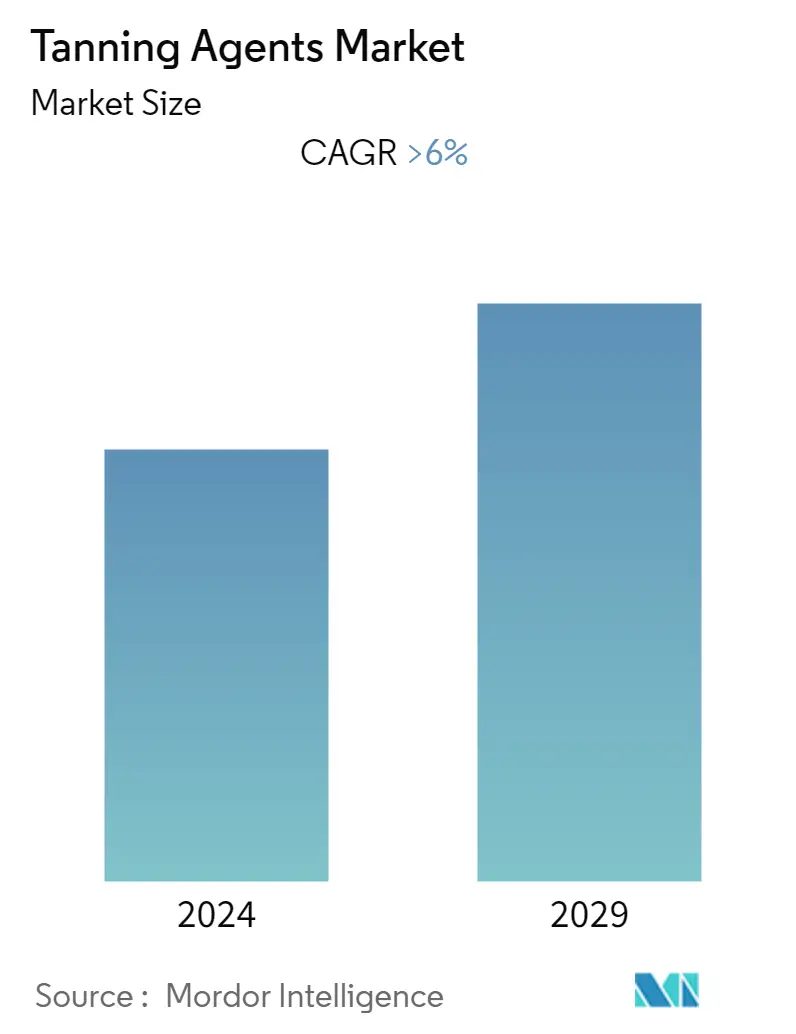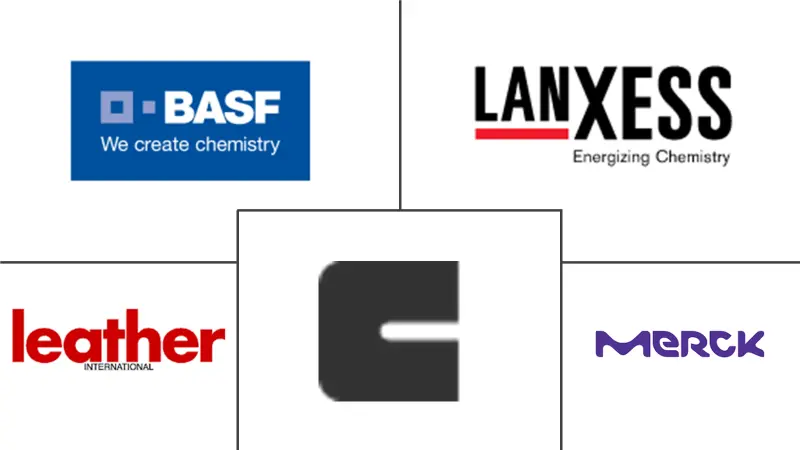Market Size of Tanning Agents Industry

| Study Period | 2019 - 2029 |
| Base Year For Estimation | 2023 |
| CAGR | 6.00 % |
| Fastest Growing Market | Asia Pacific |
| Largest Market | Asia Pacific |
| Market Concentration | High |
Major Players
*Disclaimer: Major Players sorted in no particular order |
Tanning Agents Market Analysis
The global tanning agents market is anticipated to register a CAGR of more than 6% during the forecast period.
COVID-19 negatively impacted the market in 2020. However, the market is now estimated to reached pre-pandemic levels and is expected to grow steadily.
- The rapid increase in demand for high-quality leather is expected to drive market growth during the forecast period.
- High operational costs and stringent environmental regulations are anticipated to hinder the market's growth.
- An increase in investment in R&D to develop alternate tanning technologies will likely create opportunities for the market in the coming years.
- Asia-Pacific region is expected to dominate the market and is also likely to witness the highest CAGR during the forecast period.
Tanning Agents Industry Segmentation
Tanning agents are chemicals that keep the collagen fibers in leather from disintegrating. A tanning agent removes water from the interstices between protein fibers and bonds them together. Vegetable tannin, mineral salts such as chromium sulfate, and fish or animal oil are the three most commonly used tanning agents. The tanning agents market is segmented by type, application, and geography. By type, the market is segmented into inorganic materials, aldehyde tanning agents, vegetable tanning agents, and other types. By application, the market is segmented into leather tanning, sun tanning personal care products, and other applications. The report also covers the market size and forecasts in 15 countries across major regions. Market sizing and forecasts are based on revenue (USD million) for each segment.
| Type | |||||
| |||||
| |||||
| Vegetable Tanning Agents | |||||
| Other Types |
| Application | |
| Leather tanning | |
| Sun Tanning and Personal Care Products | |
| Other Applications |
| Geography | |||||||
| |||||||
| |||||||
| |||||||
| |||||||
|
Tanning Agents Market Size Summary
The tanning agents market is poised for steady growth, driven by the increasing demand for high-quality leather. Despite the initial setbacks caused by the COVID-19 pandemic, the market has rebounded to pre-pandemic levels and is expected to continue its upward trajectory. The leather-tanning application is the fastest-growing segment, with chrome tanning being widely used due to its desirable properties. The market's expansion is supported by the diverse applications of leather-tanned products in industries such as footwear and packaging. However, the market faces challenges from high operational costs and stringent environmental regulations. Nonetheless, advancements in research and development aimed at alternative tanning technologies present new opportunities for growth.
The Asia-Pacific region is anticipated to dominate the global tanning agents market, with countries like China, India, Japan, and South Korea leading the charge. The region's burgeoning footwear and personal care industries are significant contributors to the increased consumption of tanning agents. In particular, China's status as the world's largest footwear producer and India's expanding personal care sector are key factors driving market growth. The market is partially consolidated, with major players such as BASF SE, LANXESS, and Merck KGaA playing pivotal roles. Recent innovations, such as Schill+Seilacher GmbH's SUCCUIR system and Smit & Zoon's Nera and Zeology products, highlight the ongoing advancements within the industry, further supporting the market's positive outlook.
Tanning Agents Market Size - Table of Contents
-
1. MARKET DYNAMICS
-
1.1 Drivers
-
1.1.1 Rapid Increase in Demand for High Quality Leather
-
1.1.2 Other Drivers
-
-
1.2 Restraints
-
1.2.1 High Operational costs
-
1.2.2 Stringent Environment Regulations
-
-
1.3 Industry Value Chain Analysis
-
1.4 Porter's Five Forces Analysis
-
1.4.1 Bargaining Power of Suppliers
-
1.4.2 Bargaining Power of Consumers
-
1.4.3 Threat of New Entrants
-
1.4.4 Threat of Substitute Products and Services
-
1.4.5 Degree of Competition
-
-
-
2. MARKET SEGMENTATION (Market Size in Value)
-
2.1 Type
-
2.1.1 Inorganic Materials
-
2.1.1.1 Chromium
-
2.1.1.2 Zirconium
-
2.1.1.3 Others
-
-
2.1.2 Aldehyde Tanning Agents
-
2.1.2.1 Formaldehyde
-
2.1.2.2 Glutaraldehyde
-
2.1.2.3 Others
-
-
2.1.3 Vegetable Tanning Agents
-
2.1.4 Other Types
-
-
2.2 Application
-
2.2.1 Leather tanning
-
2.2.2 Sun Tanning and Personal Care Products
-
2.2.3 Other Applications
-
-
2.3 Geography
-
2.3.1 Asia-Pacific
-
2.3.1.1 China
-
2.3.1.2 India
-
2.3.1.3 Japan
-
2.3.1.4 South Korea
-
2.3.1.5 Rest of Asia-Pacific
-
-
2.3.2 North America
-
2.3.2.1 United States
-
2.3.2.2 Canada
-
2.3.2.3 Mexico
-
-
2.3.3 Europe
-
2.3.3.1 Germany
-
2.3.3.2 United Kingdom
-
2.3.3.3 Italy
-
2.3.3.4 France
-
2.3.3.5 Rest of Europe
-
-
2.3.4 South America
-
2.3.4.1 Brazil
-
2.3.4.2 Argentina
-
2.3.4.3 Rest of South America
-
-
2.3.5 Middle-East and Africa
-
2.3.5.1 Saudi Arabia
-
2.3.5.2 South Africa
-
2.3.5.3 Rest of Middle-East and Africa
-
-
-
Tanning Agents Market Size FAQs
What is the current Tanning Agents Market size?
The Tanning Agents Market is projected to register a CAGR of greater than 6% during the forecast period (2024-2029)
Who are the key players in Tanning Agents Market?
BASF SE, LANXESS , Merck KGaA, Leather International and CLARIANT are the major companies operating in the Tanning Agents Market.

